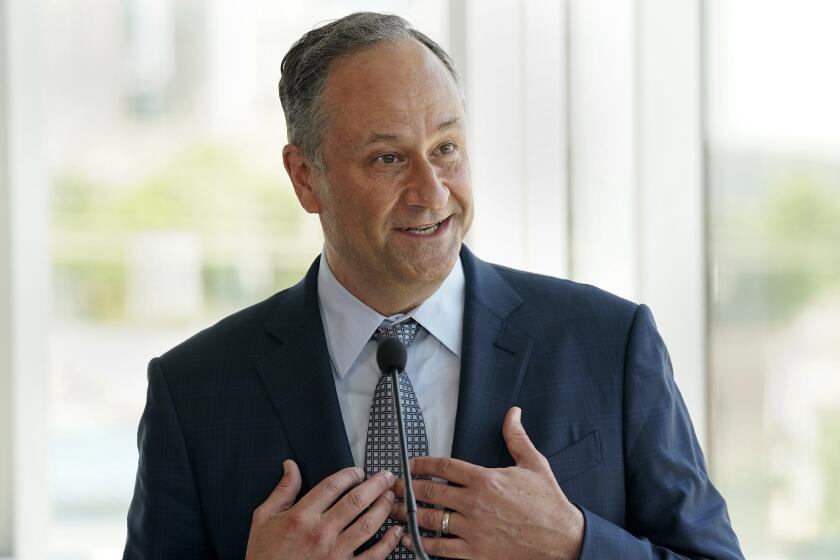Administration Sees Growth of 3% This Year : Reagan’s Top Economic Adviser Gloats Over Egg on His Critics’ Faces
- Share via
WASHINGTON — The Reagan Administration, with its chief economist mocking critics of his earlier forecast of robust economic growth, predicted Thursday that the economy will grow a healthy 3% in 1988 instead of the modest 2.4% growth expected at the beginning of the year.
“Our rosy forecast wasn’t rosy enough,” said Beryl W. Sprinkel, chairman of President Reagan’s Council of Economic Advisers.
Providing support for the new forecast was the latest report from the Commerce Department showing that the economy’s output expanded at a 3.6% rate during the first quarter of the year, only slightly less than the 3.9% estimated last month.
“The economy is doing better than even we expected,” Sprinkel said in a backhanded acknowledgment that White House forecasts frequently have been challenged as too optimistic. But with recent Administration predictions proving to be more accurate than most, Sprinkel was clearly in a mood to gloat.
Profits Fell
“Prospects for continued prosperity have seldom been better,” he told reporters at a White House briefing. “This expansion . . . gives every indication of continuing at least through the end of this Administration and on into the next year.”
The Administration’s new economic forecast, together with expectations that farm subsidies should fall by at least $5 billion next year because of higher prices caused by the drought, should ease fears that automatic spending cuts will go into effect this fall under the Gramm-Rudman budget law.
The slight revision in the first-quarter gross national product report is mainly attributable to slightly lower consumer spending, which grew at a still-strong 3.8% rate instead of the 4.3% estimated earlier. The Commerce Department also reported that after-tax profits of U.S. corporations fell by 1% in the first quarter instead of the 0.5% rise estimated earlier.
The White House forecast of 3% growth from the fourth quarter of 1987 to the fourth quarter of 1988 will be achieved if the nation’s gross national product just grows at a modest 2.8% annual rate in the final three quarters of the year.
Private analysts said the rapid rise in U.S. exports and business investment that is expected to fuel growth in the economy for the rest of the year should make that target relatively easy to reach.
With nearly half of 1988 already completed, “there’s too much pep in the economy” to expect any significant slowdown until near the end of the year, said Jerry Jasinowski, chief economist for the National Assn. of Manufacturers.
While economists found little fault with the Administration’s new GNP forecast, some said its new projection of restrained inflation and only modest increases in interest rates do not reflect the impact of stronger growth and the potentially devastating effect on food prices of the widespread drought in much of the nation’s Farm Belt.
“He’s certainly right about better growth . . . but the rest is just pie-in-the-sky stuff,” complained Michael Evans, an economic consultant in Washington.
The White House has predicted that inflation, as measured by the consumer price index, will hit 4.3% this year but only 3.9% in 1989. Many analysts expect inflation to rise to 5% or more. At the same time, the White House forecast calls for interest rates this year to average only about a half a percentage higher than last year, which would require them to fall from current levels.
Expected to Slow
Sprinkel conceded that the drought could have “a significant effect on food prices” but dismissed fears that an increase in farm prices would revive an inflationary price spiral. “Our economy is not overheating, as sometimes feared,” he said.
The Administration bases its inflation and interest rate predictions on the expectation that economic growth will slow somewhat this year from the first-quarter pace. Sprinkel said growth projections for 1989 and beyond are being revised downward slightly to offset the higher expectations for 1988 and the stronger-than-expected growth experienced last year.
“For those of you who are always trying to figure out what we are thinking,” he said, “it means we envision some decline in interest rates later this year.”
More to Read
Get the L.A. Times Politics newsletter
Deeply reported insights into legislation, politics and policy from Sacramento, Washington and beyond. In your inbox twice per week.
You may occasionally receive promotional content from the Los Angeles Times.









